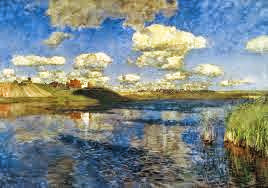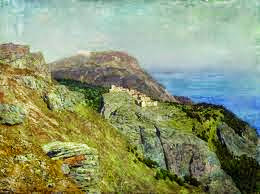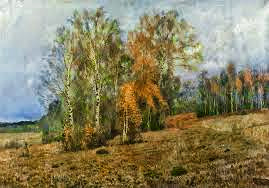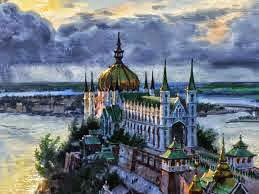Isaac Ilyich Levitan (sinh ngày 30/8/1860, mất ngày 4/8/1900) là một họa sĩ tranh phong cảnh người Nga gốc Do Thái nổi tiếng. Với những tuyệt tác như Mùa thu vàng hay Rừng bạch dương, Levitan được coi là một trong những họa sĩ Nga nổi tiếng nhất vào cuối thế kỉ 19. Isaac Levitan sinh trong một gia đình gốc Do Thái nghèo nhưng có học thức ở thị trấn Kibarty, tỉnh Kovno (nay là Kaunas, Litva). Năm Levitan lên 10 thì cả gia đình chuyển về Moskva.
Tháng 9 năm 1873, Isaac Levitan thi đỗ vào Trường hội họa, điêu khắc và kiến trúc Moskva nơi anh trai của ông, Avel, cũng đã theo học được hai năm. Ở trong trường, Levitan được học các họa sĩ phong cảnh nổi tiếng của Nga lúc bấy giờ là A. K. Savrasov, V. G. Perov và V. D. Polenov. Levitan học rất giỏi và được nhận học bổng của trường. Tuy vậy khi học được hai năm thì mẹ của Isaac mất, cha ông thì lâm bệnh nặng và không thể tiếp tục hỗ trợ bốn anh chị em Levitan học tập chỉ nhờ vào mỗi tiền công từ việc dạy thêm do ông đã phải nghỉ công việc trong ngành đường sắt, sau đó ông cũng mất năm 1877 vì bệnh thương hàn. Cả gia đình Levitan lâm vào cảnh nghèo túng, bản thân Isaac Levitan thường xuyên phải nhịn đói hoặc ngủ lại trường nhưng nhờ có sự hỗ trợ của các giáo sư vốn yêu quý tài năng của Levitan, ông mới có thể tiếp tục việc học tập. Do cuộc sống thiếu thốn và việc học tập vất vả, sức khỏe và tinh thần của Levitan đã bắt đầu giảm sút ngay từ những năm này. Ông tốt nghiệp năm 1885.
Tháng 3 năm 1877, hai tác phẩm đầu tiên của Isaac Levitan được triển lãm và được báo chí đánh giá cao. Sau vụ mưu sát của Aleksandr Soloviev nhằm vào Nga hoàng Aleksandr II (1818 – 1881) tháng 5 năm 1879, lệnh trục xuất hàng loạt người Do Thái ra khỏi các thành phố lớn của Đế quốc Nga buộc gia đình ông phải chuyển đến vùng ngoại ô Saltykovka nhưng vào mùa thu các quan chức chính quyền dưới áp lực của những người hâm mộ nghệ thuật đã cho phép ông quay trở lại Moskva.
Thập niên 1880, bức tranh Ngày thu. Sokolniki của Isaac Levitan được nhà sưu tập tranh hàng đầu nước Nga là Pavel Mikhailovich Tretyakov mua lại. Mùa xuân năm 1884, Levitan tham gia vào cuộc triển lãm tranh lưu động của nhóm họa sĩ Peredvizhniki (nhóm họa sĩ lưu động) và đến năm 1891 thì trở thành thành viên chính thức của nhóm này cùng với các họa sĩ nổi tiếng khác như I. N. Kramskoi, K. A. Korovin.
Trong thời gian còn học ở Trường hội họa, Isaac Levitan kết bạn cùng các họa sĩ K. A. Korovin, M. V. Nesterov, kiến trúc sư Fyodor Shekhtel và họa sĩ N. P. Chekhov, anh trai của nhà văn nổi tiếng A. P. Chekhov, sau đó tác giả tranh phong cảnh nổi tiếng Levitan và tác giả truyện ngắn nổi tiếng Chekhov đã trở thành những người bạn thân thiết, Levitan thường đến nghỉ tại nhà Chekhov trong những giai đoạn khủng hoảng về tinh thần.
Giai đoạn từ 1889 tới 1890 ông tới Pháp và Italia.
Ngay từ khi còn ở trường Levitan đã bộc lộ thiên hướng về tranh phong cảnh và phần lớn các tác phẩm sau này của họa sĩ đều tập trung vào đề tài phong cảnh nông thôn hoặc thiên nhiên nước Nga. Những tác phẩm theo trường phái hiện thực của Levitan nổi tiếng với khả năng miêu tả chân thực vẻ đẹp của thiên nhiên Nga, đồng thời cũng truyền vào đó cảm xúc và tinh thần của tác giả. Có thể kể tới các bức tranh Mùa thu vàng miêu tả mùa thu ở vùng nông thôn Nga với sắc vàng chủ đạo, bức Rừng bạch dương vẽ lại những cánh rừng bạch dương Nga vào mùa xuân với sắc xanh chủ đạo hay bức Cái yên tĩnh vĩnh hằng miêu tả thiên nhiên hùng vĩ nhìn từ một nhà nguyện nhỏ bé nằm giữa một con sông nước Nga. Levitan là người vẽ trời rất đẹp, người ta đã ví Levitan vẽ trời đẹp như là Claude Monetvẽ nước.
Năm 1897, Levitan được bầu vào Viện hàn lâm nghệ thuật Nga và năm 1898 ông trở thành người phụ trách xưởng tranh phong cảnh tại trường học cũ của mình. Tuy nhiên càng về sau, sức khỏe của Levitan càng yếu, ông thường xuyên bị viêm phổi và suy sụp về tinh thần. Vì vậy họa sĩ thường dưỡng bệnh tại gia đình của người bạn Chekhov ở Krym. Tại đây đã có lần Levitan dùng súng tự tử nhưng không chết. Tuy nhiên, Levitan chưa bao giờ truyền tâm trạng u tối của mình vào trong các bức tranh, hầu hết các bức tranh của Levitan, kể cả bức cuối cùng Hồ (hay Tổ quốc) đều mang màu sắc tươi tắn và miêu tả tuyệt vời vẻ đẹp của thiên nhiên nước Nga. Chưa kịp hoàn thành tác phẩm Hồ thì Levitan qua đời ngày 4 tháng 8 năm 1900 khi mới 40 tuổi. Isaac Levitan ban đầu được chôn ở nghĩa trang của người Do Thái ở Dorogomilovo, nhưng sau đó ông được cải táng về nghĩa trang nổi tiếng ở Moskva, Nghĩa trang Novodevichy, mộ của ông nằm kế bên mộ của người bạn thân Chekhov. Ngoài những người bạn và đồng nghiệp, Levitan chưa bao giờ lập gia đình hay có con.
Isaac Ilyich Levitan; August 30, 1860 - August 4 [O.S. July 22] 1900)
was a classical Russian landscape painter who advanced the genre of the "mood landscape".
Youth
Isaac Levitan was born in a shtetl of Wirballen, Augustów Governorate in Congress Poland, a part of the Russian Empire (present-day Lithuania) into a poor but educated Jewish family. His father Elyashiv Levitan was the son of arabbi, completed a Yeshiva and was self-educated. He taught German and French in Kowno and later worked as a translator at a railway bridge construction for a French building company. At the beginning of 1870 the Levitan family moved to Moscow.
In September 1873, Isaac Levitan entered the Moscow School of Painting, Sculpture and Architecture where his older brother Avel had already studied for two years. After a year in the copying class Isaac transferred into a naturalistic class, and soon thereafter into a landscape class. Levitan's teachers were the famous Alexei Savrasov, Vasily Perov and Vasily Polenov.
In 1875, his mother died, and his father fell seriously ill and became unable to support four children; he died in 1877. The family slipped into abject poverty. As patronage for Levitan's talent and achievements, his Jewish origins and to keep him in the school, he was given a scholarship.
Early work
In 1877, Isaac Levitan's works were first publicly exhibited and earned favorable recognition from the press. After Alexander Soloviev's assassination attempt on Alexander II, in May 1879, mass deportations of Jews from big cities of the Russian Empire forced the family to move to the suburb of Saltykovka, but in the fall officials responded to pressure from art devotees, and Levitan was allowed to return. In 1880 his painting Осенний день. Сокольники (Autumn day. Sokolniki) was bought by famous philanthropist and art collector Pavel Mikhailovich Tretyakov. (See also Tretyakov Gallery)
In the spring of 1884 Levitan participated in the mobile art exhibition by the group known as the Peredvizhniki and in 1891 became a member of the Peredvizhniki partnership. During his study in the Moscow School of painting, sculpturing and architecture, Levitan befriended Konstantin Korovin, Mikhail Nesterov, architect Fyodor Shekhtel, and the painter Nikolay Chekhov, whose famous brother Anton Chekhov became the artist's closest friend. Levitan often visited Chekhov and some think Levitan was in love with his sister, Maria Pavlovna Chekhova.
In the early 1880s Levitan collaborated with the Chekhov brothers on the illustrated magazine "Moscow" and illustrated the M. Fabritsius edition "Kremlin". Together with Korovin in 1885-1886 he painted scenery for performances of the Private Russian opera of Savva Mamontov.
In the 1880s he participated in the drawing and watercolor gatherings at Polenov’s house.
The landscape of mood
Levitan's work was a profound response to the lyrical charm of the Russian landscape. Levitan did not paint urban landscapes; with the exception of the View of Simonov Monastery (whereabouts unknown), mentioned by Nesterov, the city ofMoscow appears only in the painting Illumination of the Kremlin. During the late 1870s he often worked in the vicinity of Moscow, and created the special variant of the "landscape of mood", in which the shape and condition of nature are spiritualized, and become carriers of conditions of the human soul (Autumn day. Sokolniki, 1879). During work in Ostankino, he painted fragments of the mansion’s house and park, but he was most fond of poetic places in the forest or modest countryside. Characteristic of his work is a hushed and nearly melancholic reverie amidst pastoral landscapes largely devoid of human presence. Fine examples of these qualities include The Vladimirka Road, 1892 Evening Bells, 1892, and Eternal Rest, 1894, all in the Tretyakov Gallery. Though his late work displayed familiarity with Impressionism, his palette was generally muted, and his tendencies were more naturalistic and poetic than optical or scientific.
Late life
In the summer of 1890 Levitan went to Yuryevets (Юрьевец) and among numerous landscapes and etudes he painted The View of Krivooserski monastery. So the plan of one of his best pictures, The Silent Monastery, was born. The image of a silent monastery and planked bridges over the river, connecting it with the outside world, expressed the artist's spiritual reflections. It is known that this picture made a strong impression on Chekhov.
In 1897, already world-famous, he was elected to the Imperial Academy of Arts and in 1898 he was named the head of the Landscape Studio at his alma mater.
Levitan spent the last year of his life at Chekhov’s home in Crimea. In spite of the effects of a terminal illness, his last works are increasingly filled with light. They reflect tranquility and the eternal beauty of Russian nature.
He was buried in Dorogomilovo Jewish cemetery. In April 1941 Levitan's remains were moved to the Novodevichy Cemetery, next to Chekhov's necropolis. Levitan did not have a family or children.
Isaac Levitan's hugely influential art heritage consists of more than a thousand paintings, among them watercolors, pastels, graphics, and illustrations.


































































































No comments:
Post a Comment